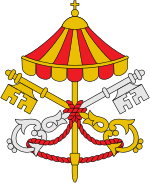1958 conclave

Coat of arms during the vacancy of the Holy See
|
|
| Dates and location | |
|---|---|
| 25–28 October 1958 Sistine Chapel, Apostolic Palace, Vatican City |
|
| Key officials | |
| Dean | Eugène Tisserant |
| Sub-Dean | Clemente Micara |
| Camerlengo | Benedetto Aloisi Masella |
| Protodeacon | Nicola Canali |
| Secretary | Alberto di Jorio |
| Election | |
| Ballots | 11 |
| Elected Pope | |
|
Angelo Roncalli Name taken: John XXIII |
|
 |
|
The Papal conclave of 1958 occurred following the death of Pope Pius XII on 9 October 1958 in Castel Gandolfo, after a 19-year pontificate. The conclave to elect his successor commenced on 25 October and ended three days later, on 28 October, after eleven ballots. The cardinal electors chose Angelo Roncalli, then Patriarch of Venice, as the new pope. He accepted the election and took the pontifical name of John XXIII.
The conclave was held from 25 to 28 October, at the Sistine Chapel in the Vatican. The papabili included the conservative Giuseppe Siri, Archbishop of Genoa, and the liberal Giacomo Lercaro, Archbishop of Bologna.
Because Pope Pius XII had held only two consistories (in 1946 and 1953) during his tenure, the College of Cardinals—whose maximum size, as set by Pope Sixtus V in the sixteenth century, was then seventy—was noticeably short of members. There were fifty-four cardinal electors, of whom twelve had been elevated by Pope Pius XI, but due to travel restrictions imposed by their Communist governments, József Mindszenty and Aloysius Stepinac were not able to travel to Rome. Edward Mooney died before the conclave, leaving fifty-one electors who participated in the conclave, and thus a potential Pope needed only thirty-five votes.
...
Wikipedia
